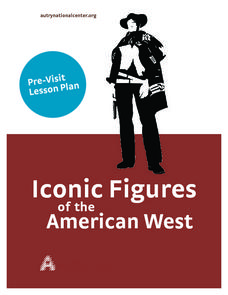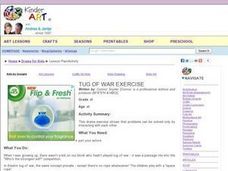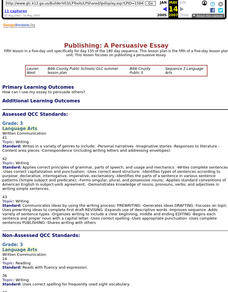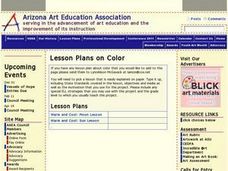Curated OER
A Monster's World
Students will use texture to create imaginary monsters and learn about the African American inventor Jan Earnst Matzeliger.
Curated OER
Winter Wonderland Windows
Learners practice painting landscapes on windows and participate in hands-on activities to expose them to different types of media. They create a winter wonderland effect on windows.
Curated OER
Get to Know: Plants
Students complete a research activity in a schoolyard or park to learn about plants. In this plant lesson, students learn the name of the one of more plants. Students describe or draw the plant, pointing our features that distinguish the...
Curated OER
A Horse of a Different Color
Elementary schoolers explore the wide variety of horse coat colors and reproduce an existing color as well a create their own horse coat color. There are two fine worksheets embedded in this plan that learners use to crete these coat...
Curated OER
Comparing Themes Across Texts
Read various texts to compare the themes across each text. Learners write a journal entry describing the most beautiful scenery they've seen and use a map of the United States to locate the Sequoia National Park and Muir Woods. They then...
Curated OER
Color Combinations
Students develop a basic understanding of how color is perceived by the eye. They utilize the technique Seurat used to paint A Sunday on La Grande Jatte to create their own paintings.
Curated OER
Synthesis of Information
Locating and synthesizing information is an essential part of the research process but can be overwhelming for many young writers. Eliminate some of the stress and confusion, this resource suggests, by separating these steps. To focus...
Curated OER
Western-Genre Films
Young scholars watch westerns and analyze them. They identify the plot, characters and the sounds in the film. They research icons of the American west and prepare a presentation. They share their presentation with the class.
Curated OER
Performance of routine movements
Students explore movement in dance routines. They observe movements and transform everyday gestures into choregraphy. Through activities, students develop improvisational skills. They evaluate and critique work.
Curated OER
Magical Maps
Second graders discuss the importance of using maps and how they are used. After they listen to a folktale, they develop their own story line maps and write their own folktale to accompany a map. They also identify and locate the seven...
Curated OER
Tug of War Exercise
Learners hone their acting and imagination by playing tug-o-war with an imaginary rope. Each group works together and pretends to pull the other group over the imaginary line with an imaginary rope. This could be a good improve warm up...
Curated OER
Pantomime Exercise
Learners of any age can learn to communicate using gestures and their bodies. They create a pantomime of a specific activity without using any words. This resource includes a link to an Off-Broadway Workshop for kids.
Curated OER
Icky Sticky Fingers
Practice recognizing the short vowel /i/ in written and spoken language. Introduce the target sound with a fun tongue twister about Lizzy the lizard. Through matching and listening activities, learners discriminate the vowel sound /i/...
Curated OER
Clothing Color Wheel
High schoolers are introduced to the primary, secondary and tertiary colors. Individually, they place the colors into the correct sequence and create their own color wheel. To end the lesson, they share their color wheel with the class...
Curated OER
Lessing meets Haring
Students create a challenging mural that functions as visual storytelling and encourages graffiti prevention. They examine the history of their town, pose questions about public art and view artwork by Keith Haring for inspiration.
Curated OER
Historians Interpret Sources
Students read excerpts from the historian Conover Hunt writing about John F. Kennedy and from primary source documents using the handout: Historical Sources and Historians. Students discuss and identify source types, evaluate sources,...
Curated OER
Persuade Me
Seventh graders give persuasive presentations based on the questions they have researched. They examine appropriate delivery techniques for effective persuasive presentations. (Note: This instructional activity should be taught, after...
Curated OER
That Quaffing and Drinking Will Undo You
Students do a close character study of the characters in scenes 1.3 and 2.3 from Twelfth Night. They read a primary source about the effects of drunkenness and examine its role in the characters of Sir Toby and Sir Andrew. Students...
Curated OER
Publishing: A Persuasive Essay
Third graders are given an opportunity to create a visual to accompany their presentations of their persuasive essays. They may use the computer or other media as resources.
Curated OER
Warm and Cool: Sun
First graders think about the sunshine colors and brainstorm the different colors found in the sunshine and identify warm colors and cool colors. They create a painting of a sun usin only warm colors using tempera paint and basic...
Curated OER
Destination UK: England
Students study life in England using a guided visualization of London, looking at statistics, reading a website, and map work. They participate in an activity that based on Cockney Rhyming Slang and look a the culture.
Curated OER
Fireplace detail
Students investigate the different type of architectural designs for fireplaces. They participate in a discussion that starts with several key questions. The lesson progresses and students complete the worksheet accompanying the lesson.
Curated OER
Color Theory & Using Layers
Students practice layering colors while creating three distinct backgrounds using the educational software TealPaint in this High School Art and Technology lesson. A slideshow, a quiz, and a color PowerPoint Slide show are included.
Curated OER
Fools Following the Fools
Young scholars read "The Winter's Tale" in Foole Upon Foole to determine the qualities the author used for a fool. Students role play the character to determine how volume affects the way a character is perceived. Young scholars...























